Marc Hartzman's Blog
August 29, 2025
Goat Has An Explosive Appetite, Freaks Out Entire Town
What would you do if your goat ate half a pound of nitroglycerin in gelatin form and then gobbled two sticks of dynamite? In November 1923, this question made front-pages news—and puzzled authorities in Aurora, Illinois, who feared approaching the loaded animal. After all, he could blow at any second.
One idea suggested that the goat be lured into a corner with a tasty head of cabbage and then chloroformed and detonated on a dump heap. Though a volunteer would still be required to do the dangerous deed. Its owner, Dick McMahon, rejected the plan, refusing the kill the goat. He felt confident it would digest the dynamite “as completely as he had racing sulky tires and similar delicacies.” The explosives had been stored in a shed by workers digging a well.
 Macomb Daily By-Stander (Macomb, Illinois), November 15, 1923.
Macomb Daily By-Stander (Macomb, Illinois), November 15, 1923.McMahon had been given the goat by Harry Reno, a millionaire printer in Chicago, who’d been given the goat by gum manufacturer and Chicago Cubs owner, William Wrigley.
According to reports, the goat was well liked by race horses sharing the pasture, and taking him away from the horses might dampen their spirits.
The press reveled with a series of jokes, including: “A goat in Aurora, Illinois, ate two sticks of dynamite and may become the Aurora Borealis soon.” But no reports of a goat explosion followed.
<br />(adsbygoogle = window.adsbygoogle || []).push({});<br />
The post Goat Has An Explosive Appetite, Freaks Out Entire Town appeared first on Weird Historian.
August 27, 2025
The Martians are Coming! Author David Baron Speaks About His New Book, “The Martians”
Is there life outside of Earth? More than a hundred years ago, there was widespread belief that intelligent Martians were an advanced civilization and contact with our interplanetary neighbors was inevitable. Science journalist and author David Baron explores this early fascination with Martians in his new book, THE MARTIANS: The True Story of an Alien Craze that Captured Turn-of-the-Century America (Liveright: Aug. 26, 2025), and discusses the many strange and amazing extraterrestrial tales with Weird Historian.
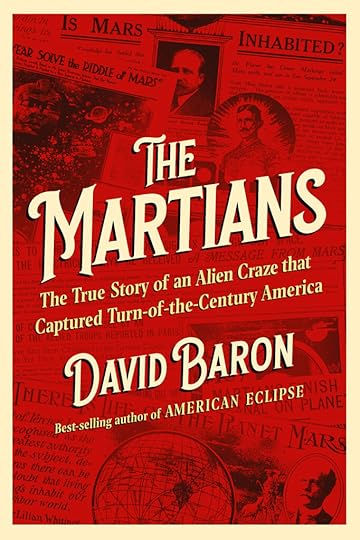 The Martians, by David Baron (Liveright, 2025).
The Martians, by David Baron (Liveright, 2025).If you’ve been following this site for a while, you know that I, too, am fascinated by the turn-of-the-century Martians. They led me to my 2020 book, The Big Book of Mars. So I was especially delighted to speak with Baron about his discoveries and fascination. Our conversation about intelligent Martians, Percival Lowell and Camille Flammarion’s firm beliefs in them, communication ideas, and much more follows below (or listen on the Weird Historian podcast):
Weird Historian: Nice to speak with you, David! Tell me a little bit about your background and how it led to your discovery of the Martians.
David: Well, so a couple of answers. I’ve been a science journalist my whole career, so going on 40 years. And then I got into writing books. I’ve always been interested in telling science stories in a way that I hope will appeal to people who don’t think they care about science. I suspect you might say the same thing. I look for great characters and great stories that will hopefully carry people along—and I might teach them a little science along the way. So, I’ve written a book back in the early 2000s called The Beast in the Garden. It’s about the growing conflict between people and large predators. It was about a fatal mountain lion attack here in Colorado. But then my second book was American Eclipse and that came out in 2017 and that was a whole different thing where I was writing science history and that’s the true story of a total solar eclipse that crossed America’s Wild West in 1878 and helped inspire America’s rise as a scientific power. But it’s just a fascinating tale of the Wild West and Thomas Edison who was in Wyoming for the eclipse and this all-female expedition from Vasser that came out to Denver in 1878.
So after writing American Eclipse, I was interested in doing science history again and I really was racking my brain to find a good historical tale that had to do with science that maybe would have some connection to the American West where I live and would have some relevance today. And I remembered learning about Percival Lowell when I was a kid. And it took me a while to remember how I learned of it. And it was from Carl Sagan in his Cosmos series on TV back in 1980. And so I always knew that there was this guy named Percival Lowell who convinced himself and a good portion of the public that Mars was inhabited by intelligent beings. And when that popped into my head, I thought, well, that’s a story that has relevance today for number of reasons and the more I looked into it the more fascinated I became.
 Author David Baron
Author David BaronMarc: Yeah, Percival Lowell’s story is an amazing one. As you began researching Lowell, did you start to uncover other Martian stories in the periphery, or did you know some of the others happening in that same era?
David: So I knew that Nicola Tesla had come to Colorado sometime in the late 1890s and thought he got radio signals from Mars. So that was also in the back of my head. But what really did it for me—having spent several years writing my previous book, American Eclipse, where I spent months just looking through old newspapers—was doing a search on Martians in some digital databases of newspapers from the turn of the last century. It just all came alive because here were these full-page articles with banner headlines proclaiming the existence of the Martians and all sorts of things, how the Martians were sending us signals and attempts to communicate back with them. And the stories of these supposed canals—a lot of it was in the so-called yellow press, the tabloid press, but there it was in the New York Times in 1906. And that’s what really convinced me that this is a forgotten part of history.
This appropriate for your website, this weird bit of history that has ripples that have come down to today. And when I was a kid in the 1960s, I grew up with Martians. They were in Bugs Bunny cartoons. There was Marvin the Martian. There was a sitcom called My Favorite Martian that my family watched. They were Martians and comic books and sci-fi novels. And this is where they came from. Before they were staples of science fiction, not that long ago, they were really thought to be scientific fact.
WH: Yeah, it really is incredible that this was front page news around the world. It wasn’t even just focused here. I also had known about Tesla when I first started discovering the Martians, and I started looking at newspaper archives for stories about him to actually write for this site when I first started it. And before I found the stories on Tesla I was looking for, I stumbled across a story about a guy in London who was telepathically communicating with a Martian woman in 1926. And I was like, “What is this? What?!” So I dug into that and I got so absorbed in it. And then I kind of found all these other stories going on as well—like you said, a forgotten part of history. This was just like a common belief amongst the most respected scientists.
One thing I found fascinating—and I’m curious if you found the same thing—is that I grew up always knowing about the War of the Worlds panic from 1938 with the Orson Wells version on the radio. And that to me as a kid was ridiculous. How could anyone believe Martians landed? They fled in the streets? This just sounded silly. But all of a sudden you realize like that they had been primed for decades with front page headlines on the New York Times, as you said, in other newspapers from well-respected scientists that Martians were there and they were intelligent trying to communicate with us. With that context, aside with other things going on during the period, it doesn’t seem so crazy anymore.
David: Absolutely. Yeah, there was one thing that I actually left out of my book. I had thought at one point about opening my book in 1938 but it just felt a little too cliched. But I had ended up tracking down a man who must have been well into his eighties—a guy who was a kid at the time and told me about how they lived in Newark and they fled their home. There actually have been people lately who have been saying the whole 1938 panic was overblown, that people really didn’t flee. They did! Maybe not in the numbers that people tend to think, but here this family really fled and yeah, it makes perfect sense. I quote in my book this woman who wrote a letter to Orson Wells afterwards, chastising him for making her so scared, but explaining why she was so scared because didn’t scientists say that there were canals on Mars? So, yeah, it was not that crazy.
WH: I also love the fact that so many people missed the beginning of that broadcast when Welles announced it was a dramatization because they were listening to a ventriloquist on the radio.
David: Yeah. Yeah. Right. Exactly.
WH: What?! Now, that’s weird. Was there a particular theory on ways we could contact Martians or receive their messages that really stood out to you?
David: Well, there were quite a few. A lot of them were visual. The one that Camille Flammarion, the French scientist, talked about explores how would you establish contact with another planet where you have no idea what kind of language they have. But he was saying, well, one thing that presumably any intelligent civilization would know about is geometry. So why don’t we communicate with geometry? You know, with a giant array of lights on the earth that trace out a circle and then we’d see if they showed us a circle back and then we would do a square and maybe they would reply with a square and then we would do a triangle. You’re not communicating very much, but at least you’re communicating, “Hello, we really exist.”
So that was one idea. But there was this idea that a Harvard astronomer had to put together a whole array of mirrors to reflect sunlight toward Mars and to use Morse code flashing dots and dashes. Not that the Martians would know what that meant.
Then the most obvious thing was radio, which is of course what Nikola Tesla was proposing and what he actually thought he received, which were radio signals from the Martians. And the thing is that folks at the time thought it was crazy that radio signals could go all the way from Mars to the Earth, which of course today we know of course we do that all the time sending back images from our rovers on Mars. So people didn’t believe him in part because they wondered how radio signals go that far.
WH: I always liked the idea of using the universal language of mathematics to somehow show there’s intelligence here.
David: Also, I should say, of course, is that lot of people believed in telepathy at the time and there was thought we could communicate with the Martians telepathically and there were people who thought they were doing that. So that was also certainly talked about as a suggestion for how we would communicate with the Martians.
WH: Yeah, there was thought that Martians communicated telepathically, I think, because of the thin atmosphere and using antenna to transmit thoughts would be easier that having a voice be transmitted.
David: Well, I hadn’t heard about. It may be true, but there was this lingering idea that Martians might actually be the souls of dead humans. That was an idea that Camille Flammarion in France wrote about. So perhaps they were disembodied souls or maybe they had bodies there, but they had gone across from one planet to the other just as spirits and so maybe we could communicate with them that way.
WH: Yeah. Well, as long as we’re talking about spiritualism, I did want to ask you a little bit about that. What are your thoughts on why Martians appealed not only to scientists but to spiritualists and mystics? I know you mentioned Helene Smith, the medium, who claimed to have visited Mars and was writing in a Martian language. What needs or hopes do you think people were projecting onto Mars at that time?
David: This was one of those subjects—and you probably found the same thing—where the deeper I went the more fascinating it became. It just became richer and richer. And when I started out it all seemed a little silly and whimsical and I would say that is how the public treated it at first. So in the 1890s and maybe the very beginning of the 20th century, a lot of the writing about Mars people weren’t totally sold on. I mean, they thought it might be true, but they thought it was kind of fun. And so Martians appeared in vaudeville skits and Tin Pan Alley songs and people wrote silly poems about them.
But it really turned serious after that. Particularly when Percival Lowell pretty well convinced a lot of serious people that his theory was right. And that’s when it really invaded religion. And I think the reason people were so keen to believe in the Martians is by then, for several centuries, science had been undermining so many traditional religious beliefs, from Galileo to Copernicus to Newton to Darwin, the findings of science seem to be leaving very little room for God. Or at least a God who was intimately involved in our daily affairs. So maybe it was a God who created the universe, but where was there room for God when everything that happened from, you know, physical things and the evolution of species seemed to be explainable by just plain old natural forces? And here came Percival Lowell kind of giving the public back deities, because the Martians, despite what H.G. Wells wrote about, suggesting that the Martians were these evil monsters set out to destroy us, that was not the widespread belief about the Martians. That was really such a small part of it. I mean generally the Martians were seen as highly evolved intellectual, technologically savvy, but also moral and peaceful beings. And here they were, these this superior civilization on the planet next door. And there were a lot of these depictions of the Martians watching us, I mean, literally with their telescopes, keeping an eye on Earth. I think that gave people a great sense of comfort, particularly after traditional religious ideas had been undermined by science. Here, science was giving us back this sense that we weren’t alone and in fact we were being watched over by beings who could perhaps answer life’s mysteries.
I was fascinated when I came across this sidebar article that was read in a number of newspapers. I think it was in 1909. It was a list of questions the Martians might answer. And this is again when there was talk of how we might communicate with the Martians. So what would we ask them? Well, it wasn’t practical things like, “How do you build an airplane?” or “How do you construct a canal?” which would be obvious. It was, “What’s the meaning of life?” and “How do you prevent human suffering?” and “Where does the soul go when you die?” That’s what the Martians were supposed to answer for us.
WH: The mysteries of life!
David: So what started out for me as this sort of fun whimsical story became very profound. I think it really is a story of our great longing not to be alone and wanting to find purpose and meaning in the universe.
WH: That’s really well said. And to your point about the difference of H.G. Wells’s Martians, the evil Martians, versus the more general perception, I found that before War of the Worlds, all the writing was more of projecting Mars as a utopian society. I saw it as a way to say, “Hey, why don’t we act more like them?” The Martians were said to be so devout, and because they were so devout, look how great life was there. So the thought was, if we’re more devout here, things could be better here, too.” It felt like for religious leaders, it was a way to help improve morals and behaviors on Earth.
David: People were projecting onto Mars. I mean this was true of Lowell, projecting onto Mars what he hoped and believed was there as opposed to what was really there. But the general public was doing the same thing. So the question is, how did this craze happen? Well, part of it was because of Percival Lowell and Flammarion and Giovanni Schiaparelli, but why was there this fertile ground where these ideas flourished? And that said more about I think where the public was at the time—that people really wanted to believe it was true.
WH: Yeah, I think so. And as weird as it all is, looking back to me, it’s so important that it all happened and I’m wondering your thoughts on how all that Martian madness ultimately had an impact on science and pop culture.
David: Right. So, on the one hand, it all seems like a silly story, but it had profound effect—profoundly good effects—on the way things developed in the 20th century. So first of all, there was a huge effect on literature. Science fiction emerged from the Martian craze. H.G. Wells was writing what today we would call science fiction in the 1890s, but the modern science fiction came about in the teens and the twenties of the 20th century. And the man who is credited as the father of science fiction is a fellow named Hugo Gernsback, after whom the Hugo Awards are named. And Gernsback said the reason he got excited about outer space and wanting to imagine travel among the stars and so forth was because of reading what Percival Lowell said about Mars when he was a kid. That was true of a lot of folks. The children at the time who just found this so exciting and invigorating this idea of beings on the planet next door and it changed their lives.
The other big fiction of the time, well, one of the big fiction writers of the time was Edgar Rice Burroughs who is most famous for his Tarzan books, but he wrote this whole series about Mars and the adventures of John Carter—an Earthling on Mars. These book, for much of the early 20th century got a lot of kids excited, including Carl Sagan, who attributed his interest in becoming a planetary scientist to reading Edgar Rice Burroughs’s Mars books that came directly out of Lowell’s view of Mars. So it inspired science fiction. It inspired scientists. It inspired rocketry itself. Robert H. Goddard the father of American rocketry. The man who built the first liquid-fueled rocket was a teen in the 1890s and read The War of the Worlds. And it was that that he attributed his interest in figuring out, well could we actually go to Mars? How would we do it?
So it was that excitement, even though it was excitement about something that wasn’t true in the end, it was that imagining what might be out there that really inspired folks. For instance, I think even today, if we’re ever going to get to Mars, which I hope we will, and I think we will, it’s not ultimately the rocket fuel that’s going to get us there. It’s the enthusiasm and the imagination of the general public. It’s people saying, “Wow, we want to do this.” And that comes from ultimately, Percival Lowell who really lit the fuse of getting people excited about Mars that has filtered down through the generations.
WH: Absolutely. I agree with everything you said and I’ll add one thing going back to the John Carter series you mentioned: John Carter starts in the first book waking up in a cave in Arizona.
David: Yeah. Right.
WH: I always imagine it’s probably just outside of Lowell’s observatory in Flagstaff.
David: Exactly.
WH: Yeah, those influences are pretty amazing. And of course, now we’ve got robots on Mars. So, one more question: Despite all that we’ve learned about Mars that’s different than what was believed a century ago, but also given what we’ve learned about extremophiles, do you think that we may yet find Martians? Just in the very different form than they thought back in those days?
David: It’s absolutely possible. We now know that early in its history, Mars had at least periods when it was quite lush. There’s evidence that there are rivers and lakes on Mars. There’s sedimentary rocks there that were laid down in water. There’s every reason to think that Mars was habitable in its early years. Life emerged on Earth pretty early in Earth’s history. We don’t know how life comes about, but if it came about so quickly on Earth, it could well have come about quickly on Mars. So there may well once have been, again, we’re probably talking about microbes on Mars, and it’s quite possible that those microbes continue to exist today. They probably would be hidden underground somewhere. But it is possible that there are Martians. But even more mind-bending, it is possible that we are all Martians. Because as I say, life may well have emerged on Mars early in its history. We know that there are rocks from Mars that make their way to Earth. And particularly, this would have been true early in both Earth and Mars history when a lot of material was being blasted off the planets and being exchanged. An there is this theory called panspermia that says that life may travel from planet to planet. And so it is possible that if life emerged on Mars before it emerged on Earth and life was transported from Mars to Earth early in its history that Mars may have seeded life here. And so if we do find life on Mars, one of the big things we want to find out is how similar to life on Earth is it? Because if it turns out it’s quite similar, it might suggest that either life on Earth seeded life on Mars or the other way around.
WH: Yeah, it really is fascinating. I like how you were just describing that. I’ve often thought that, too. Maybe life was on Mars way back when and couldn’t thrive the way it’s been able to here. Did it end up here on a meteorite and suddenly it had the environment it needed to grow into us. And maybe we’ll just make our way back home in the end.
David: Lowell, of course, got it all wrong. I don’t mean to suggest that Lowell was some genius who has been proved right today by any means. Obviously, there’s no civilization in it. But it’s interesting that his theory was that Mars had once been a lush, wet planet and it was running out of water.
WH: Yeah.
David: And that actually has turned out to be true. There wasn’t a civilization that grew up there before it started running out of water. And I think it’s just a coincidence that he’s right about that. But it is interesting that he’s right.
WH: I’m hoping at some point they’re able to get beneath the surface and see if they can find something. I was fascinated learning about the Labeled Release experiment on Viking and the positive results for life that Dr. Gil Levin and Pat Straat found. I’d spoken with them and they swore by their data and NASA never repeated those tests. And now we know that there’s ice under the ground. And I know it’s not easily accessible, but the elements are there, at least for microbial life, so could very well be something there. It continues to fascinate and hopefully we’ll find some answers in the near future.
David: Yeah, I hope so.
For much more on this subject, pick up a copy of David Baron’s THE MARTIANS: The True Story of an Alien Craze that Captured Turn-of-the-Century America.
<br />(adsbygoogle = window.adsbygoogle || []).push({});<br />
The post The Martians are Coming! Author David Baron Speaks About His New Book, “The Martians” appeared first on Weird Historian.
August 13, 2025
The Strangest Book on Earth: Take a Peek Behind the Sideshow Curtain with Showman C. M. Christ
In 2003, I spent a few days in Gibsonton, Florida—Gibtown, for those in the know—with Ward Hall and Chris Christ. The two legendary showmen ran the World of Wonders sideshow and had been in the business for decades. Hall shared stories with me for hours, which was hugely helpful in my research for American Sideshow. Chris was quieter, content to let Hall do most of the talking.
With so many years of experience, traveling, and working with the world’s most unusual people, they had no shortage of tales. Hall, in fact, had filled two books of his own with them: My Very Unusual Friends, and Struggles and Triumphs of a Modern Day Showman. In 2014, Tim O’Brien wrote his biography, Ward Hall: King of the Sideshows.
Sadly, Ward Hall passed away in 2021 at age 88.
Chris Christ remains in Gibsonton. And despite their longtime partnership, they’ve got different stories. Lots of them. Fortunately, they’re now available in the new book, Strangest Show on Earth: Tales of the Midway as Told to Kevin Gerrone by C. M. Christ (Ballyhoo Press).
 Strangest Show on Earth is now available from Ballyhoo Press.
Strangest Show on Earth is now available from Ballyhoo Press.Christ recounts the good times, the bad times, and the truly bizarre times. Among the former was a stint with the Roller Brothers Circus: “There is nothing like being on the circus, and Roller Brothers was no exception. Helen Carpenter had the lion act. It was just four old lions, but there is nothing more peaceful than being out in the country on a humid night listening to them roar as you fall asleep. Like taking a handful of valium. It’s wonderful.”
Other tales share fond memories of Toby, Christ’s trained chimpanzee and friend, and not-so-fond memories of having his pickled punks (two-headed babies in jars) confiscated and later buried.

And then there was working with Burt Ward— better known as Robin from television’s campy Batman series of the 1960s. Christ doesn’t mince words about Robin, who was hardly the Boy Wonder:
Burt Ward was the absolute drizzling shits; he was terrible. He had some young girl, and they did something with a person in a gorilla costume, but it wasn’t a gorilla parody. It was some piece of shit that he had written.
Things got worse one evening when Robin started complaining in bad weather “I’m soaking wet and covered in mud,” Christ recalled.
Then “Robin” comes to me and says that he can’t work under these conditions. I’m not in the greatest mood, I’ve been out there since seven in the morning in the mud, and it’s six o’clock at night. I said, “Motherfucker, if you don’t work tonight you don’t ever work again.” The purchasing agent was there, and I told him to go someplace around here and get some mud boots for this guy to wear because he is going to work. I told him, “Either you are going to get a little muddy and work, or you are not going to be in any condition to work.” I was going to punch him out; I had about all his shit that I could handle.

Kevin Gerrone has been documenting stories of showmen for many years—all of whom have become close friends. Many can be found in his recently launched journal, On the Inside. But for a real, raw insider’s peek behind the curtain, Strangest Show on Earth delivers wonderfully and captures a unique era in the outdoor amusement business.
Weird Historian interviewed Gerrone about the book and putting it all together with Christ.
When and where did you first meet Chris?
I have known Chris and Ward for many many years. I can’t remember if I met them in their home in Gibtown or out on the midway.
What led to the idea to write the book? Did you approach Chris with the concept, or did he reach out to you?
There has been so much written by and about Ward and so little about Chris. Ward was the spotlight guy by design. Chris did a lot of behind-the-scenes, so to say, work. One night Chris and I were sitting on his back porch cutting it up and we both kinda looked at each other and said…. Why not? Though Ward and Chris were partners for over 50 years they both have their own stories. Most have never heard Chris’s and it’s a shame. He is such an asset to the business. One hell of a showman. This book will give the readers a different look at not only how Ward and Chris worked together for all those years, but about the changes that took place in the business.
What was your process in putting Strangest Show together with Chris?
Chris is one of my closest friends. We have spent a lot of time together and talk pretty much every day. I try and spend as much time in Gibtown as I can—and I ALWAYS have my recorder on me when I’m around show people. We did a lot of recording at his house as well as over the phone. But the majority was recorded in Gibtown.
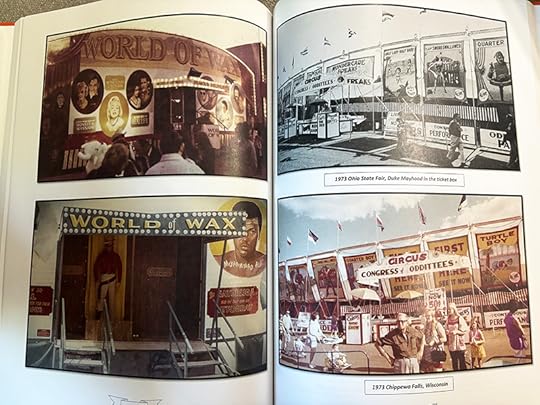
What are some of your favorite stories captured in the book?
The book is loaded with jackpots. My favorite one is the 1977 raid at Grayslake, Illinois, when the pickled punk show was busted and Chris was arrested. But, there is so much more…. How he met Ward and became partners, how he went bankrupt and built a circus, and Chris working for Ted Turner as a promoter for WCW wrestling.
What do you hope readers take away from reading it?
My hope is that this book will provide an idea of what it was like when there still were shows on the carnival midway. Ever since I was little I have been obsessed with the carnival business. I have interviewed lots of old showmen, sadly most have passed away. I promised every one of them to try and preserve as much of their history as I can. Unfortunately, there is more than I’ll ever be able to print.
Any upcoming projects you can tell us about?
I’m working on a few new projects but the third issue of my publication On the Inside is on top.
Want a copy of Strangest Show on Earth ? You can purchase the book via Facebook at the Ballyhoo Press page or by emailing Ballyhoopress@gmail.com
<br />(adsbygoogle = window.adsbygoogle || []).push({});<br />
The post The Strangest Book on Earth: Take a Peek Behind the Sideshow Curtain with Showman C. M. Christ appeared first on Weird Historian.
August 4, 2025
The Werewolf of Bedburg: Peter Stump’s Damnable Life and Death
In 1589, a grim spectacle unfolded in the German town of Bedburg. A man named Peter Stump (also spelled Stumpf, Stubbe, or Stubbe) was accused of being a werewolf—and not just any werewolf, but one of the most monstrous in recorded lore. Tortured into confession, Stump claimed he had practiced black magic since age twelve and pledged himself to the Devil.
A 1590 English pamphlet titled The Damnable Life and Death of Stubbe Peeter recounts:
The Devil, who hath a ready ear to listen to the lewd motions of cursed men, promised to give him whatsoever his heart desired during his mortal life: whereupon this vile wretch neither desired riches nor promotion, nor was his fancy satisfied with any external or outward pleasure, but having a tyrannous heart and a most cruel bloody mind, requested that at his pleasure he might work his malice on men, women, and children, in the shape of some beast, whereby he might live without dread or danger of life, and unknown to be the executor of any bloody enterprise which he meant to commit.
The Devil obliged, bestowing upon him a magical girdle, allowing him to transform into a ravenous wolf—“strong and mighty, with eyes great and large, which in the night sparkled like unto brands of fire, a mouth great and wide, with most sharp and cruel teeth, a huge body and mighty paws.” Under this supposed spell, he admitted to a 25-year reign of terror.
 A page from the 1590 pamphlet, “The Damnable Life and Death of Stubbe Peeter.”
A page from the 1590 pamphlet, “The Damnable Life and Death of Stubbe Peeter.”According to his confession, Stump murdered and cannibalized fourteen children and two pregnant women, devouring their unborn fetuses. He confessed to killing his own son and feasting on the boy’s brain “as a most savory and dainty delicious mean to staunch his greedy appetite.” The allegations didn’t stop there—Stump was also charged with incest, said to have fathered a child with his daughter and engaged in relations with a succubus sent by the Devil himself. It was a confession soaked in blood, sin, and supernatural horror.
His execution on October 31, 1589—before the date was celebrated at Halloween—was equally theatrical and brutal: he was strapped to a wheel, had his flesh torn with red-hot pincers, his limbs broken, and was finally beheaded before being burned. His daughter and mistress were also put to death for allegedly aiding in his crimes.
 The execution of werewolf Peter Stump, on October 31, 1589.
The execution of werewolf Peter Stump, on October 31, 1589.The story is one of many featured in Montague Summers’ 1933 book, The Werewolf. While Summers, who also wrote extensively on witches and vampires, appeared to be a believer, modern scholars certainly debate the truth behind the werewolf of Bedburg (and any werewolves). Some view it as a politically or religiously motivated show trial during a time of intense Catholic-Protestant conflict. Others interpret it as an early example of how societies demonize outsiders or explain horrific crimes through the lens of folklore. Whether madman, scapegoat, or monster, Peter Stump remains one of history’s most infamous werewolves.
<br />(adsbygoogle = window.adsbygoogle || []).push({});<br />
The post The Werewolf of Bedburg: Peter Stump’s Damnable Life and Death appeared first on Weird Historian.
July 8, 2025
Merry Widow Hats Were Not Always So Merry
 Merry Widow Hats were all the rage in the early 1900s.
Merry Widow Hats were all the rage in the early 1900s. A Merry Widow Hat, for those unfamiliar with turn-of-the-century fashion, was an oversized hat popularized not by cheerful widows, but by actress Lily Elsie in the 1907 operetta The Merry Widow. These extravagant hats—often nearly two feet wide—were typically made of straw and lavishly adorned with feathers, French lace, or other decorative accessories.
Though stylish, in at least one case, they also proved dangerous. Just ask Joseph Lewis, a local farmer in Bloomington, Illinois. In October 1908, he got an unexpected close-up of one such hat when he rounded a corner in a rush to catch a train and collided with the massive brim. As an article reported, the corner of the hat “pierced Lewis’ eye, inflicting an injury which speedily cost him the vision.” Doctors feared the farmer might lose sight in his other eye “through sympathy.”
As for the woman with the gigantic headgear, “she kept on her way ignorant of the unfortunate mishap which befell Lewis.” Evidently, she too was in quite a hurry.
In the image below, printed in The Minneapolis Journal on May 3, 1908, it’s clear that others saw Merry Widow Hats as a menace—one that could create even more widows.
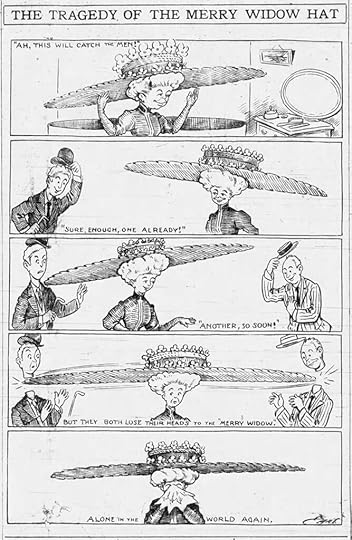 As seen on the front page of The Minneapolis Journal, May 3, 1908.
As seen on the front page of The Minneapolis Journal, May 3, 1908.The post Merry Widow Hats Were Not Always So Merry appeared first on Weird Historian.
June 19, 2025
A Fatal Case of the Famed Bullet Catch
On Saturday, March 23, 1918, tragedy struck on stage as famed magician Chung Ling Soo performed his bullet catch trick—and was shot in front of his audience. He’d performed the trick many times, but on this occasion, something went awry and when the gun was shot, the bullet left the chamber and struck Soo.
“After the bullets were fired Soo usually staggered, and when he fell we thought it was the usual performance,” his stage manager told reporters. “He then called out, ‘Oh, my God!’ and on going to him we found that the bullet had passed right through him.”
The story of Soo, who was really William Ellsworth Robinson, has been well told in Jim Steinmeyer’s The Glorious Deception (2005) and Will Dexter’s The Riddle of Chung Ling Soo (1955).
 Published in 1955. Collection of Marc Hartzman.
Published in 1955. Collection of Marc Hartzman.Soo, however, wasn’t the first magician to die from the bullet catch. In fact, there were many, as detailed in Dexter’s book. One of them occurred on November 10, 1820, in Arnstadt, Germany. Polish magician De Linsky and his wife had been summoned by Prince Schwartzburgh Sondershauser for a performance. The prestidigitator saw it as an opportunity to broaden his tour of Europe afterward and command greater fees. So the show had to be good.
“On the way, they have been arguing,” Dexter wrote. “He has had a brilliant idea: they will do the bullet-catching trick, and the Prince’s bodyguard shall be the marksmen!”
Madame de Linsky protested the idea. “We must first teach the soldiers what they are to do, and who knows whether they will understand us? Remember—they may be foreign mercenaries. They may not understand our German. Please, Auguste. … I am afraid!”
She had also just lost a child and was pregnant with another. So risking a bullet catch in another country with the trigger being pulled by a stranger wasn’t her idea of a great show. But the magician insisted and assured her that nothing could possibly go wrong.
Then, of course, it did.
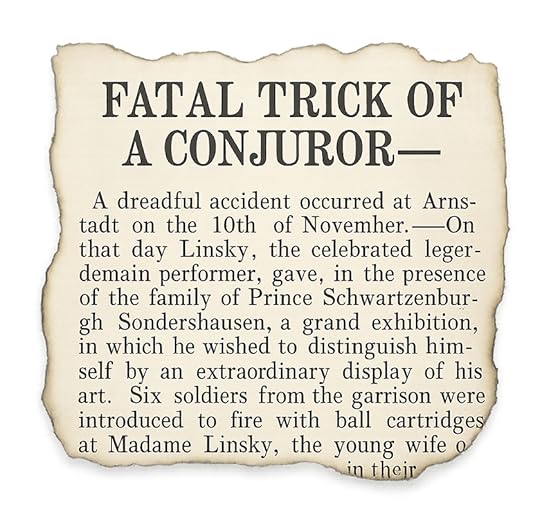
Despite the conjuror’s instructions, once they were on stage a soldier who did not follow directions properly pulled the trigger. It passed right through Madame DeLinsky.
“For a moment after the firing she remained standing upright, but the next moment she sunk down saying, ‘Dear husband, I am shot,’” a newspaper reported. “The unfortunate woman never spoke another word, and died on the second day after she received the wound.”
Many in the audience fainted, and DeLinsky suffered greatly at the shock of it.
As the newspaper concluded: “It is to be hoped that this event will serve as a warning to all conjurors, as well as the spectators of their tricks, who usually show too inconsiderate a confidence in the art of the performer, not only with respect to cases of risk of life, but to other practices of a dangerous nature.”
Soo, as you know, didn’t heed the warning. Nor did several of history’s other magicians who suffered the same fate from their own versions of the bullet catch.
<br />(adsbygoogle = window.adsbygoogle || []).push({});<br />
The post A Fatal Case of the Famed Bullet Catch appeared first on Weird Historian.
June 8, 2025
Why Do Sword Swallowers Do It? Hear It Straight From Their Steel-Guzzling Mouths in the To The Hilt Podcast.
 Cyrus Pynn, the Swashbuckling Sword Sword Swallower.
Cyrus Pynn, the Swashbuckling Sword Sword Swallower.What makes someone decide they want to shove two feet of steel down their throat? And make a living out of it? In the new To The Hilt podcast, co-hosted and produced by your Weird Historian, Marc Hartzman, and world-famous sword swallower Dan Meyer, you’ll hear a series of fascinating discussions with modern-day swallowers.
 The To The Hilt podcast is available on Spotify, Apple Podcasts, Amazon Music, and iHeartRadio.
The To The Hilt podcast is available on Spotify, Apple Podcasts, Amazon Music, and iHeartRadio.The podcast is in support of our new book, To The Hilt: A Sword Swallower’s History of Sword Swallowing, published by Schiffer Publishing.
Guests so far have included:
The Lizardman: The Modified Marvel and former Jim Rose Circus performer who’s fully tattooed like a lizard.George “The Giant” McArthur: The world’s tallest sword swallower who was featured in Tim Burton’s Big Fish.Jim Ball: At 90 years old, he’s the world’s oldest sword swallower and longest-performing sword swallower—having started at age 12, when he was the world’s youngest sword swallower.Brianna Belladonna: Mistress of Mayhem, who’s swallowed swords on How I Met Your Mother, AMC’s Freakshow, and countless other places.Red Stuart: The Living Legend who’s been swallowing swords every day since 1967—not to mention car axles.Cyrus Pynn: A swashbuckling sword swallower, juggler, equilibrist, and knife thrower.Brad Byers: A sword swallower who also juggles, rides a unicycle and tiny bicycles, balances on the rola bola board, walks on broken glass, yoyos, throws tops, spins suitcases and other large objects on his finger, balances a running lawn mower on his chin, and blows bubbles with a tarantula in his mouth—just to name a few of his stunts.Adam Realman: Coney Island’s artistic director and the professor at the Coney Island Sideshow School.Franz Huber: The Bavarian Daredevil, who holds nine world records, including swallowing the most curved blade (133 degrees).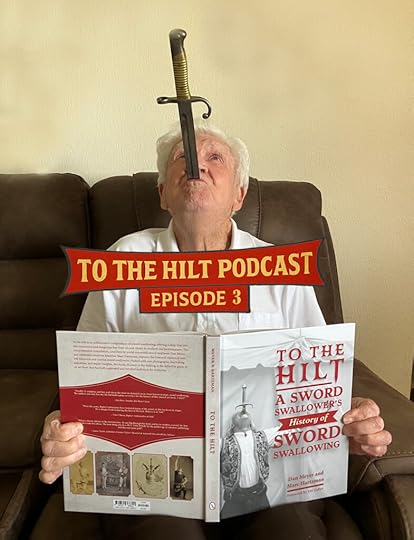 Jim Ball, the World’s Oldest Sword Swallower.
Jim Ball, the World’s Oldest Sword Swallower.
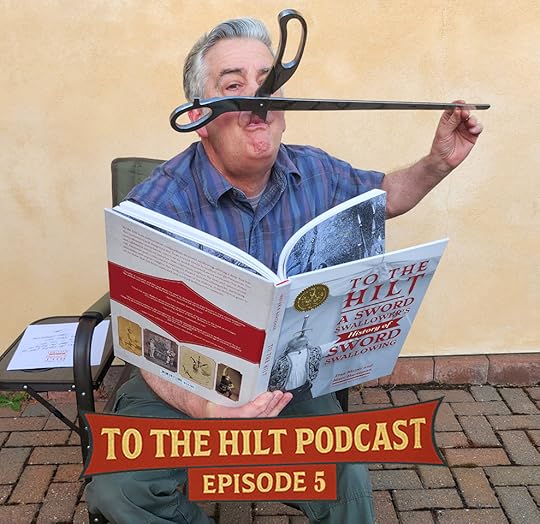 Brad Byers, Sword Swallower with a Twist
Brad Byers, Sword Swallower with a Twist
 Adam Realman, the Coney Island Sword Swallower
Adam Realman, the Coney Island Sword Swallower
 Red Stuart, the Living Legend.
Red Stuart, the Living Legend.
 Brianna Belladonna, Mistress of Mayhem
Brianna Belladonna, Mistress of Mayhem
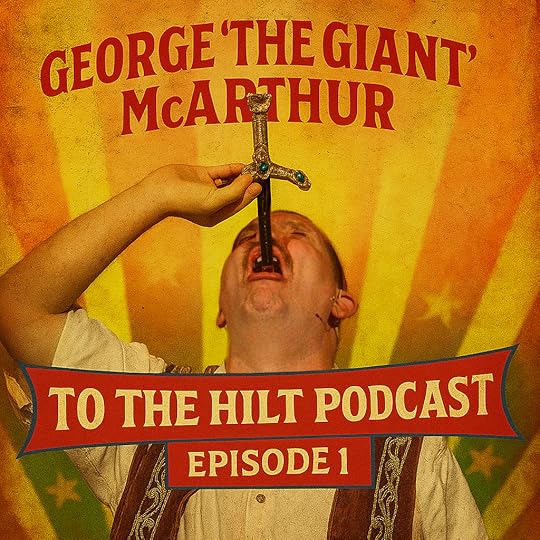 George “The Giant”McArthur, the World’s Tallest Sword Swallower.
George “The Giant”McArthur, the World’s Tallest Sword Swallower.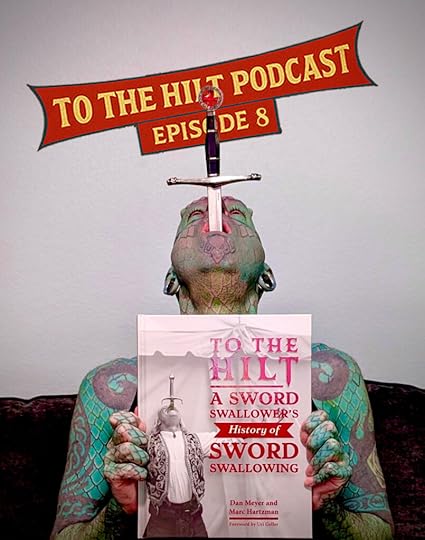 The Lizardman, the Modified Marvel.
The Lizardman, the Modified Marvel.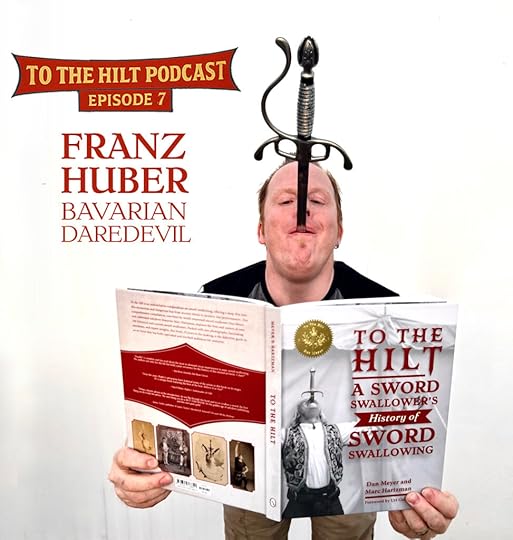 Franz Huber, the Bavarian Daredevil
Franz Huber, the Bavarian DaredevilFind out what makes them tick, how they learned, what accidents they’ve had, and why they love risking their lives to do it. Where else can you be a fly on the wall as two sword swallowers swap stories and talk shop?
Available on Spotify, Apple Podcasts, Amazon Music, and iHeartRadio.
 To The Hilt is available now. The sword swallower featured on the cover is co-author Dan Meyer.
To The Hilt is available now. The sword swallower featured on the cover is co-author Dan Meyer.Purchase To The Hilt: A Sword Swallower’s History of Sword Swallowing on Amazon or wherever else you buy books.
<br />(adsbygoogle = window.adsbygoogle || []).push({});<br />
March 26, 2025
The Strange Case of the One-Legged Man Who Assaulted a One-Armed Man with a Three-Legged Stool
During a search for news about Francesco Lentini, a legendary sideshow performer with three legs, I came across a story from January 1915 that’s even weirder than I’d hope to find about the three-legged wonder. It discussed a case of a man who, instead of having three legs, had only one. Actually, two one-legged men were involved.
 Knoxville Sentinel, January 4, 1915
Knoxville Sentinel, January 4, 1915The first one-legged man co-owned a two-seat barber shop in Wiggins, Mississippi, with a club-footed man. At the back of the shop the local justice of the peace rented space to use as an office and a courtroom. The judge had no legs, having lost both in a train wreck years earlier.
As the article continued, it described a skirmish in a neighboring town involving another one-legged man who “became a little unruly and assaulted a one-arm man with a three-leg stool.”
So the one-legged man who used a three-legged stool as a weapon was brought before the no-legged judge on assault charges against the one-armed man, with a separate one-armed serving as a witness in the building owned by another one-legged man and a club-footed man.
Go ahead, take a breath.
The offending one-legged man was sentenced to thirty days at the county farm.
And if you’re curious about Lentini, the three-legged man I was originally researching, he also had a fourth foot and a second penis. For more on him, check out my book, American Sideshow.
<br />(adsbygoogle = window.adsbygoogle || []).push({});<br />
January 15, 2025
Most Books Hope to Inspire You. This One Strongly Warns Against It.
 The world’s first book on the history of sword swallowing. Published by Schiffer Books.
The world’s first book on the history of sword swallowing. Published by Schiffer Books.To The Hilt: A Sword Swallower’s History of Sword Swallowing might be the first book to come with a doctor’s warning.
“In the event that the only sentence you read is this one, I’d like to begin by saying do not flip through this book and try to swallow a sword,” writes Dr. Brian Witcombe, radiologist, at the start of To The Hilt. “If you read on, do not take any of the anatomical descriptions below as an instruction guide. The phrase ‘Do not try this at home’ has never been more serious.”
The new book, co-authored by sword swallower Dan Meyer and sideshow historian (and Weird Historian) Marc Hartzman, delves into the lives of more than a hundred sword swallowers and includes a foreword by renowned performer Uri Geller. To The Hilt highlights the lives of sword swallowers from the early 1800s through present day, and offers an inside look at the wild stories and experiences of modern sword swallowers, who account for one out of every 300 million people alive today.
Among them, of course, is Meyer, who is widely recognized as the world’s leading expert on sword swallowing and serves as president of the Sword Swallowers Association International. He’s also the founder of World Sword Swallower’s Day, a global TED speaker, and winner of the 2007 Ig Nobel Prize in Medicine for medical research on sword swallowing. Known by Guinness World Records and Ripley’s Believe or Not as one of the world’s top sword swallowers, Meyer holds 40 world records and has performed on 16 Got Talents, at 15 Ripley’s Believe It or Not museums, on over 100 TV programs, and live in 60 countries around the world.
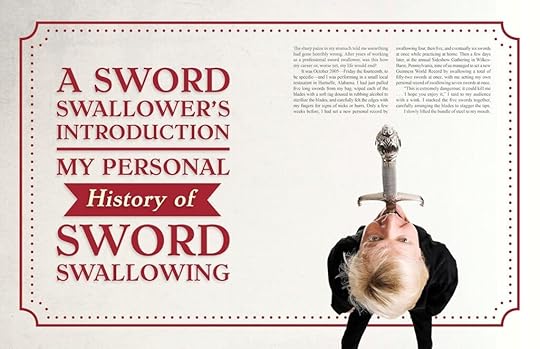 Sword swallower and co-author Dan Meyer.
Sword swallower and co-author Dan Meyer.“When I first started researching sword swallowing in 1997, there wasn’t much information available—it was truly scarce,” Meyer told Weird Historian. “So I got obsessed with finding as much about every sword swallower as I could. Eventually it became a dream to publish a book like this. Now 28 years later, the dream has become a reality!”
Together, he and Hartzman have written the definitive book on the dangerous art of sword swallowing.
In To The Hilt, you’ll also meet:
Jacques de Falaise – In 1816, de Falaise signed a contract to perform as an extreme eater—a 19th-century Joey Chestnut of sorts. But instead of gorging hot dogs, he gulped down whole potatoes, hard-boiled eggs, eels, frogs, and more. After a troupe of performers from India demonstrated sword swallowing, Falaise played a dangerous game of one-upmanship by training himself to swallow up to 14 inches of steel to enhance his act.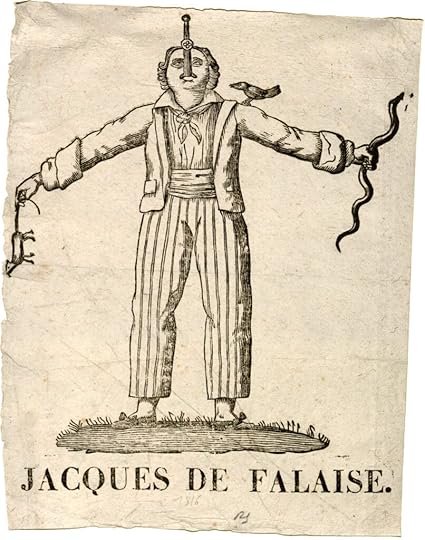 Jacques de Falaise swallows a sword while clutching a mouse in one hand, an eel in the other, a bird watching from his shoulder—and hoping it’s not next. Wood engraving, ca. 1816. Public domain, via Wikimedia CommonsChevalier Cliquot – Born as Francis McLone, his sword swallowing adventures began after running away to the circus at age 16 in the late 1870s. After being unable to pay the show’s sword swallower to train him, McClone taught himself with a 6-inch piece of silver wire. By 1902, decades after mastering the art and adopting the stage name Chevalier Cliquot, he had swallowed swords of up to 22 inches nearly every day for over twenty-three years. Cliquot’s act also included swallowing an electric lightbulb connected to an 8-volt battery, gulping down chained pocket watches and smoking a cigarette while the watch ticked in his stomach, and, as shown to the doctors, up to fourteen 19-inch bayonet swords at one time. But his biggest stunt was to partially swallow a bayonet sword, weighted with a crossbar and two 18-pound dumbbells. He’d allow the rest of the blade to be “kicked” by the recoil of a rifle that was fixed to a spike in the center of the bar and then fired. Edith Clifford – Swallowing a bayonet might not sound unusual for a sword swallower. Shooting it down your throat, however, is another story. Edith Clifford began performing the stunt as early as 1903 at Walker’s Museum in Boston. The Boston Post referred to her as “the only lady who swallows a bayonet, having attached it to a loaded cannon, and while the cannon is supported by the bayonet that is down the throat the piece is discharged.” Years later, Harry Houdini called it “the sensation of her act.”
Jacques de Falaise swallows a sword while clutching a mouse in one hand, an eel in the other, a bird watching from his shoulder—and hoping it’s not next. Wood engraving, ca. 1816. Public domain, via Wikimedia CommonsChevalier Cliquot – Born as Francis McLone, his sword swallowing adventures began after running away to the circus at age 16 in the late 1870s. After being unable to pay the show’s sword swallower to train him, McClone taught himself with a 6-inch piece of silver wire. By 1902, decades after mastering the art and adopting the stage name Chevalier Cliquot, he had swallowed swords of up to 22 inches nearly every day for over twenty-three years. Cliquot’s act also included swallowing an electric lightbulb connected to an 8-volt battery, gulping down chained pocket watches and smoking a cigarette while the watch ticked in his stomach, and, as shown to the doctors, up to fourteen 19-inch bayonet swords at one time. But his biggest stunt was to partially swallow a bayonet sword, weighted with a crossbar and two 18-pound dumbbells. He’d allow the rest of the blade to be “kicked” by the recoil of a rifle that was fixed to a spike in the center of the bar and then fired. Edith Clifford – Swallowing a bayonet might not sound unusual for a sword swallower. Shooting it down your throat, however, is another story. Edith Clifford began performing the stunt as early as 1903 at Walker’s Museum in Boston. The Boston Post referred to her as “the only lady who swallows a bayonet, having attached it to a loaded cannon, and while the cannon is supported by the bayonet that is down the throat the piece is discharged.” Years later, Harry Houdini called it “the sensation of her act.” Edith Clifford swallows a bayonet fastened to the breech of a cannon. The bayonet seen here is now owned by Dan Meyer. Collection of Dan MeyerAlex Linton – Throughout his sword-swallowing career, which began in around 1930, Linton performed alongside many notable sideshow performers, including the Doll Family, armless and legless girl Frieda Pushnik, Rasmus Nielsen, the Fischer giants, and Betty Broadbent, “the living art gallery” tattooed lady. In 1932, he also performed with the entire cast of Tod Browning’s classic film,
Freaks
, as the sideshow’s resident sword swallower. During a stint at Hubert’s Museum in New York City in the late 1930s, Billboard reported that in his ten-month stay as a knife thrower and sword swallower, he had “thrown an average of 300 bayonets a day or a total of 90,000 for the 10 months without hitting Stella, tattoo girl, his target” and had “swallowed approximately 260 feet of steel per day, or about 78,000 feet in all.” Among that 78,000 feet of steel, Linton often swallowed four 27-inch swords at once, and two with a lit cigarette sandwiched between them. It’s worth noting that those 27-inch swords were going into a 5-foot, 3-inch body. At the time, they also earned him a Guinness World Record.
Edith Clifford swallows a bayonet fastened to the breech of a cannon. The bayonet seen here is now owned by Dan Meyer. Collection of Dan MeyerAlex Linton – Throughout his sword-swallowing career, which began in around 1930, Linton performed alongside many notable sideshow performers, including the Doll Family, armless and legless girl Frieda Pushnik, Rasmus Nielsen, the Fischer giants, and Betty Broadbent, “the living art gallery” tattooed lady. In 1932, he also performed with the entire cast of Tod Browning’s classic film,
Freaks
, as the sideshow’s resident sword swallower. During a stint at Hubert’s Museum in New York City in the late 1930s, Billboard reported that in his ten-month stay as a knife thrower and sword swallower, he had “thrown an average of 300 bayonets a day or a total of 90,000 for the 10 months without hitting Stella, tattoo girl, his target” and had “swallowed approximately 260 feet of steel per day, or about 78,000 feet in all.” Among that 78,000 feet of steel, Linton often swallowed four 27-inch swords at once, and two with a lit cigarette sandwiched between them. It’s worth noting that those 27-inch swords were going into a 5-foot, 3-inch body. At the time, they also earned him a Guinness World Record.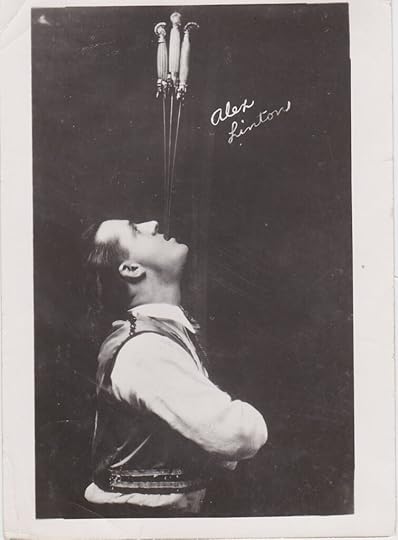 Alex Linton, Prince of Swords, swallows three blades. Collection of Dan MeyerCount Desmond – Called the “Evel Knievel of the Sword” by Knievel himself, in 1980 Desmond hanged himself upside down while spinning from a helicopter 200 feet over Niagara Falls while pushing a sword up his throat. And just to defy superstition, he did it on Friday the thirteenth.
Alex Linton, Prince of Swords, swallows three blades. Collection of Dan MeyerCount Desmond – Called the “Evel Knievel of the Sword” by Knievel himself, in 1980 Desmond hanged himself upside down while spinning from a helicopter 200 feet over Niagara Falls while pushing a sword up his throat. And just to defy superstition, he did it on Friday the thirteenth.Amongst the stories from modern-day performers is a section called “Volunteers Gone Bad,” where you’ll read about the time World of Wonders owner Tommy Breen asked a young woman in the audience to pull a blade from his throat and she inexplicably pushed it in deeper instead. Another section called “Injuries Happen” shares the story of Tyler Fyre’s escape from death after a neon tube broke when reaching the bottom of his stomach. Both are clear reminders to readers of just how real sword swallowing is.
To The Hilt is available from Schiffer Books on February 28, 2025. Pre-order today on Amazon or wherever else you buy books.
<br />(adsbygoogle = window.adsbygoogle || []).push({});<br />
December 1, 2024
Jim the Wonder Dog Truly Lived Up to His Name
When Sam VanArsdale of Marshall, Missouri, adopted Jim, a Llewellyn setter, at six weeks old, he thought the pup was “the dumbest dog I’d ever seen.” That impression didn’t last long. During a quail hunt, VanArsdale casually mentioned they should rest under a nearby Hickory tree. To his amazement, Jim headed straight to the Hickory. Intrigued, VanArsdale tested him by naming other trees—a Walnut, a Cedar, even a stump—and Jim found each one without hesitation.
 Jim the Wonder Dog was featured in the Toronto Star on February 27, 1937.
Jim the Wonder Dog was featured in the Toronto Star on February 27, 1937.“How do I account for it? I can’t. No one can,” VanArsdale told the press as Jim quickly became a national sensation. “Scientists, biologists and psychologists have come here and they might as well have known no more than some man down in the Ozarks who can neither read nor write as far as explaining Jim is concerned.”
As the above article’s headline proclaimed, this extraordinary dog could even understand Yiddish. During a study of Jim at the University of Missouri, two rabbis in attendance put his skills to the test. “That’s the most remarkable thing I’ve ever seen,” exclaimed Dr. Frederick Middlebush, president of the university. “It’s unexplainable.” VanArsdale boasted the dog could, in fact, understand any language.
Jim was even alleged to have psychic powers, evidenced by picking six straight winners in the Kentucky Derby. VanArsdale would simply place the name of each racehorse on a separate piece of paper and Jim would touch the winner with his paw.
Expecting parents from across the country wired in requests seeking the dog’s foresight for predicting the sex of their babies. “I’ve got affidavits from the parents sworn before notaries” about Jim’s accuracy, VanArsdale said. After too many requests, he stopped asking Jim to accommodate them.
The know-it-all pooch couldn’t be fooled, though some tried to stump him. Once a man tested the dog by asking him which of the three women accompanying him was his wife. Jim remained perfectly still, stretched out on the floor. The man then admitted he wasn’t married.
Naturally, a canine curiosity like Jim could have put on a remarkable stage show, but VanArsdale turned down numerous offers to commercialize him. Perhaps he made enough from horse-racing picks to keep him happy.
 Headline from Jim’s obituary in the Daily Democrat News (Marshall, Missouri), April 3, 1937.
Headline from Jim’s obituary in the Daily Democrat News (Marshall, Missouri), April 3, 1937.Jim the Wonder Dog died suddenly on March 18, 1937, at age 12, while on a fishing trip with VanArsdale. The veterinarian tending to him was unsure if the cause of death was a heart attack or a stroke, but he believed no suffering was involved.
VanArsdale always denied the use of signals and was never caught giving them. Scientists who studied him were left baffled. Today he’s memorialized at the Jim the Wonder Dog Museum & Garden in Marshall.
<br />(adsbygoogle = window.adsbygoogle || []).push({});<br />
The post appeared first on Weird Historian.



